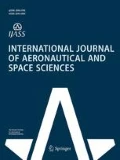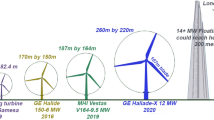Abstract
The noise sources of the tip-jet driven rotor are mainly classified as rotor blade noise and jet noise. The rotor blade noise includes thickness noise, loading noise, and nonlinear quadrupole noise, while the jet noise includes nozzle momentum noise and jet radiation noise. Each noise component has different noise source mechanisms related to flow characteristics and the rotating motion. Especially, the nozzle momentum noise has two noise source mechanisms based on the rotating steady aerodynamic load and the nozzle mass flow rate. The details of the time signal and spectrum are discussed to study the unique spectral characteristics. The tip-jet driven rotor noise has both tonal and broadband spectral characteristics. The periodicity of each instance of jet radiation noise is discussed, while the total jet radiation noise also has a tonal noise component. The noise source mechanisms and spectral characteristics are important considerations for an acoustically efficient tip-jet driven rotor.









Similar content being viewed by others
Abbreviations
- M :
-
Mach number vector with components Mi
- \(\hat{n}\) :
-
Unit outward normal vector to source surface with components \(\hat{n}_{i}\)
- \(\hat{r}\) :
-
Unit vector in the radiation direction
- u i :
-
Components of local velocity of the fluid
- v i :
-
Components of local velocity of the source surface
- P ij :
-
Compressive stress tensor with constant p0δij subtracted
- L :
-
Loading noise component
- M :
-
Inner product by Mach number vector M
- n :
-
Inner product by a unit normal vector \(\hat{n}\)
- r :
-
Inner product by a unit vector \(\hat{r}\)
- ret:
-
Term evaluated at the retarded time
- T :
-
Thickness noise component
- \(\cdot\) :
-
Derivative with respect to time
References
Leishman JG (2006) Principles of helicopter aerodynamics, 2nd edn. Cambridge University Press, New York, pp 692–722
Mitchell C, Vogel B (2003 The canard rotor wing (CRW) aircraft-a new way to fly. In: AIAA international air and space symposium and exposition: the next 100 years, AIAA paper 2003–2517, July 2003
Davidson IM, Harcest TJ (1965) Helicopter noise. Aeronaut J 69(653):325–336. https://doi.org/10.1017/S0001924000059583
Walsh GD (2016) A preliminary acoustic investigation of a coaxial helicopter in high-speed flight. Master Thesis, Aerospace Engineering Dept., The Pennsylvania State Univ., Philadelphia
Ko J, Lee S (2018) Wake optimized CFD method for wake structure and noise analysis of the coaxial rotor. In: 7th Asian/Australian rotorcraft forum, Jeju Island, Korea, 30 Oct–1 Nov 2018
Park M, Jang J, Lee D (2017) Noise prediction of ducted fan unmanned aerial vehicles considering strut effect in hover. Int J Aeronaut Space Sci 18(1):144–153. https://doi.org/10.5139/IJASS.2017.18.1.144
Moodie AM, Schrage DP, Sankar LN, Waters MH (2009) Sizing and performance-prediction method for rotary-wing ejector nozzles. J Aircr 46(3):951–961. https://doi.org/10.2514/1.39423
Crossley WA, Rutherford JW (1995) Sizing methodology for reaction-driven, stopped-rotor vertical takeoff and landing concepts. J Aircr 32(6):1367–1374. https://doi.org/10.2514/3.46887
Chen J, Li L, Huang G, Xiang X (2018) Numerical investigations of ducted fan aerodynamic performance with tip-jet. Aerosp Sci Technol 78:510–521. https://doi.org/10.1016/j.ast.2018.05.016
Brentner KS, Morris JP, Lopes LV (2014) A method for predicting the noise of a tip-jet driven rotor. J Am Helicopter Soc 59(3):1–10. https://doi.org/10.4050/JAHS.59.032004
Brentner KS, Farassat F (1994) Helicopter noise prediction: the current status and future direction. J Sound Vib 170(1):79–96. https://doi.org/10.1006/jsvi.1994.1047
Tam CKW (1995) Supersonic jet noise. Annu Rev Fluid Mech 27(1):17–43. https://doi.org/10.1146/annurev.fl.27.010195.000313
Kim S, Lee S, Kim K (2008) Wavenumber extended high order oscillation control finite volume schemes for multi-dimensional aeroacoustic computations. J Comput Phys 227(8):4089–4122. https://doi.org/10.1016/j.jcp.2007.12.013
Choi W, Lee S, Jung J, Lee S (2008) New far-field boundary and initial conditions for computation of rotors in vertical flight using vortex tube model. J Am Helicopter Soc 53(4):382–397. https://doi.org/10.4050/JAHS.53.382
Lighthill MJ (1952) On sound generated aerodynamically I. General theory. Proc R Soc Lond A 211(1107):564–587. https://doi.org/10.1098/rspa.1952.0060
Brentner KS, Farassat F (1998) Analytical comparison of the acoustic analogy and Kirchhoff formulation for moving surfaces. AIAA J 36(8):1379–1386. https://doi.org/10.2514/2.558
Purcell T (1989) A prediction of high-speed rotor noise. In: AIAA 12th aeroacoustics conference, AIAA paper 1989–1132, Apr 1989
SAE International (2013) Gas turbine jet exhaust prediction. In: SAEARP876, Revision F, SAE International, Warrendale
Holford JF (1960) Some notes on the noise from the Fairey Rotodyne. AEC21, 671 N.115, British ARC
Hubbard HH (1991) Aeroacoustics of flight vehicles: theory and practice. Volume 1. In: Noise sources, NASA Langley Research Center, Hampton, Virginia, pp 65–149
Acknowledgements
This work was conducted at High-Speed Compound Unmanned Rotorcraft (HCUR) research laboratory with the support of Agency for Defense Development (ADD). Also, this work was supported by the Korea Institute of Energy Technology Evaluation and Planning (KETEP) and the Ministry of Trade, Industry and Energy (MOTIE) of the Republic of Korea (No. 20194030202300).
Author information
Authors and Affiliations
Corresponding author
Additional information
Publisher's Note
Springer Nature remains neutral with regard to jurisdictional claims in published maps and institutional affiliations.
Rights and permissions
About this article
Cite this article
Ko, J., Kim, J., Saravanan, V. et al. Noise Sources and Spectral Characteristics of the Tip-Jet Driven Rotor. Int. J. Aeronaut. Space Sci. 22, 33–41 (2021). https://doi.org/10.1007/s42405-020-00296-1
Received:
Revised:
Accepted:
Published:
Issue Date:
DOI: https://doi.org/10.1007/s42405-020-00296-1




